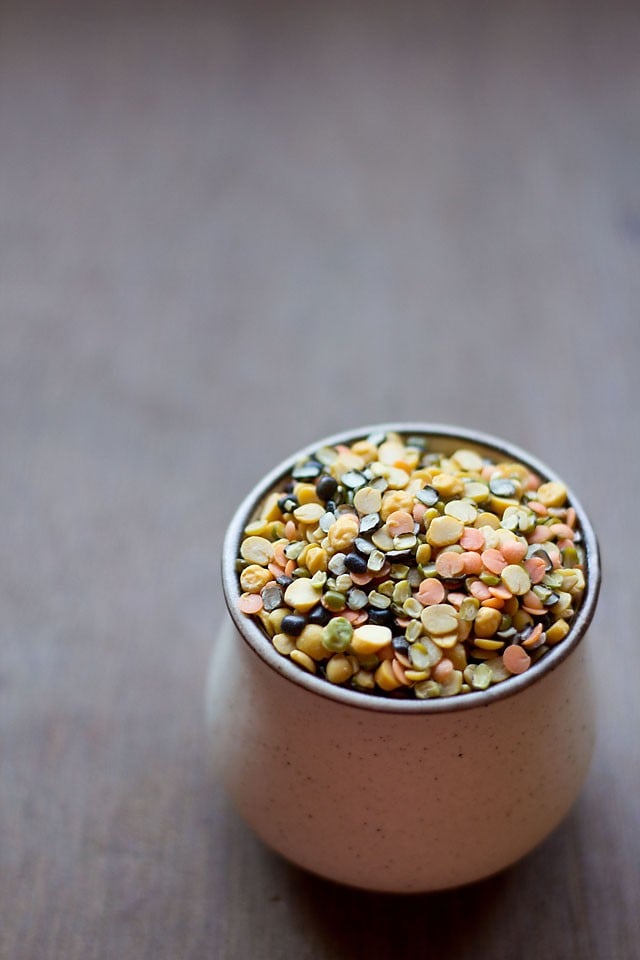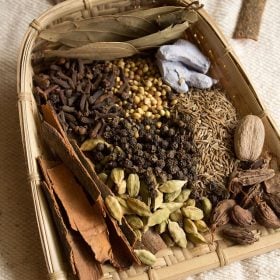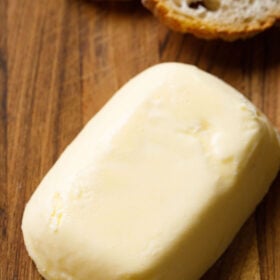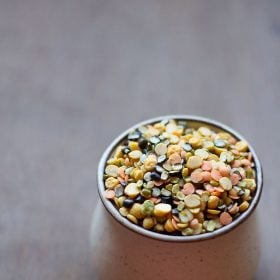The glossary or list of legumes and lentils or pulses names used mainly in Indian Cuisine is presented here. Pulses and legumes are an excellent sources of plant based proteins. In India most of the vegetarian population consumes a variety of legumes, pulses and their flours. So we have hundreds of recipes made with them. We even have sweets and desserts made with lentils. e.g. moong dal halwa, besan ladoo, chana dal payasam etc.

Just for your information:-
- In Hindi, the word ‘Sabut’ is used for lentils which are whole.
- The word ‘Dal’ or ‘Dahl’ is used for split lentils.
- The word ‘Dhuli’ is used for split and husked/skinned lentils.
How to Cook, Buy and Store Lentils and Legumes
Soaking: Some people have difficulty digesting these due to the phytic acid present in them. To make them easily digestible soak the lentils like chana dal, tuvar dal, masoor dal in water for an hour and legumes like white chickpeas, kidney beans, black chickpeas for 8 to 9 hours or overnight.
Later drain all the water and rinse the lentils thoroughly in fresh water for a couple of times. This process helps to remove some of the phytic acid.
Cooking: Soaking the lentils and beans reduces their cooking time by 25%. Once they are soaked well, you have the options to cook them in a pressure cooker or pan or in an instant pot. While cooking lentils add double to triple the amount of water. When cooking beans, add 3 to 4 times water to one cup of dried beans.
In Indian cuisine, most of our lentil dishes contain many spices and herbs that help in the digestion. e.g. cumin, ginger, asafoetida, fennel seeds, carom seeds etc. They also add a ton of flavor and aroma in the dish. I suggest that in any Indian lentil or legume recipe don’t change or omit the spices or herbs but you can change some other ingredients if they are not available to you.
Buying: While purchasing lentils and legumes make sure they are in their shelf period and not aged or old. Lentils that are old take a longer time to cook and also you don’t get the best texture and flavor in them.
If possible buy organic or locally sourced pulses and legumes. Also, try to buy unpolished pulses or lentils as they have higher nutrition than the polished ones. Moreover, they also taste better.
Preserve: To preserve lentils or their flours for a longer time so that they don’t get infested with insects, keep 1 to 2 tej patta (Indian bay leaf) or few cinnamon sticks or few pieces of cloves in the lentil jar. Keep in a cool dry place.
Note that this pulses names list is best viewed in a desktop or laptop browser. When viewing in a mobile phone or tablet, you will have to swipe the table from left to right.
The first column consists of the pulses names in English, whilst the second column consists of their names translated in Hindi, Tamil and Marathi languages. These names of the legumes, lentils are listed in alphabetical order.
Pulses Name List
| English | Hindi | Tamil | Marathi |
| Bengal gram flour | Besan | Kadalai mavu | |
| Bengal gram spilt and skinned | Chana dal, chane ki dal, Booter dal | Kadalai paruppu | Harbaryachi dal, Chanyachi dal |
| Bengal gram whole | Kala chana, chana | Harbhara | |
| Black eyed beans, cow peas | Lobhiya, lobiya, chawli, chavli | Karamani | |
| Black gram skinned | Urad dhuli | Ullutham paruppu | |
| Black gram split | Urad chilka | ||
| Black gram whole | Urad sabut, urad saboot | Muzhu ulundhu | |
| White chick peas, Garbanzo beans | Kabuli channa, Safed chole, chole | Kondai kadalai | |
| Field bean, Hyacinth bean, lablab | Val | ||
| Green gram dal | Moong dal | Payatham paruppu | |
| Green gram split | Moong chilka | Mugachi dal | |
| Green gram whole | Moong sabut, mung sabut | Payaru | Mug |
| Horse gram | Kulthi, kulith | Kollu | |
| Lentil dal, pink lentil | Masoor dal, masar dal, Masur dal | ||
| Moth bean | Moth, matki, mataki | ||
| Peas | Mutter, matar, mattar | Pattani | |
| Dried green peas | Hara matar | ||
| Dried white peas | Safed matar | ||
| Black peas | Kala vatana | ||
| Peas spilt, green peas spilt | Matar dal, green matar dal | ||
| Pigeon peas spilt and skinned | Arhar, tuvar, toor, tur dal | Thuvarum paruppu | |
| Red kidney beans | Rajma | Rajma | |
| Soybean | Bhatma |
Note – if you know the name of any legumes/lentils/pulses in any regional Indian language and want to update it in this post, then do leave it in the comment section and we will update the post. Thanks in advance for your information
If we have missed any legumes, then also you can let us know.
Related Culinary Posts
This lentils and pulses name list post from the blog archives (first published in September 2009) has been updated and republished on 26 June 2021.













Hello Amit
It was a basket of informative knowledge.
Thanks. By the way what is the local commercial name for American beans.
thanks. i am not sure what are american beans. have never seen them here in india.
Thanks a lot. very informative and great site. It was very useful for me in last hour as i was really struggling to get the names in English for importing some.
welcome dhiraj. good to know that the post helped you.
Thanks for creating this list of cross reference. What is red gram and split red lentils? Is that masoor dal or pink lentils? I have a recipe book that calls out for red pumpkin. Is that the same as the orange pumpkin we have here in the U.S. that we carve during Halloween?
i think red gram and split red lentils is masoor dal. and red pumpkin would be orange pumpkin.
TELUGU NAMES
BENGAL GRAM WHOLE: PACCHI SANAGALU
BEAGAL GRAM SPLIT: PACCHI SANAGA PAPPU
BEAGAL GRAM FRIED: VEYINCHINA SANAGA PAPPU
BENGAL GRAM FOOR: SENAGA PINDI
BLACK GRAM WHOLE: MINUMULU
BLACK GRAM SPLIT: MINAPA PAPPU
GREEN GRAM WHOLE: PACCHI PESALU
GREEN GRAM SPLIT: PESARA PAPPU
REDGRAM WHOLE: KANDULU
RED GRAM SPLIT: KADI PAPPU
GREAN PEAS : PACCHI BHATALILU
DRY GREAN PEAS: ENDU BHATANILU
thanks sreedhar for the lentil names in telugu. will try to update soon.
Can i know, if there is any common name for white beans ?!
ishi, which white beans?
hii gud work, i know the names in telugu & kannada.
thanks witerose
verkadalai{in tamil} means ground nut (in english)
subha, thanks for the info.
Hi, Sorry to bother you but would it be possible to link pictures to each of these? I’m having a hard time trying to figure out what to buy and my mum’s no where nearby to ask! Or if you know of a website that has pictures, that would be great too! Thanks so much!
welcome maya. no issue. we will add the photos soon.
Please see if you can keep the picture of each in respective rows.. it will help quickly to relate
thanks vinaya. its a good suggestion but will make the page very heavy to load. thats why we have not implemented till now. but will surely give a second thought.
Waal is a Konkan coastal bean with a hard shell and can only be cooked only when sprouted.its legume .Give synonyms.
we know. will add synonyms.
moth beans tamilnadu called as that taittai pairu
thanks thomas for sharing the info.
Please add the following Tamil translations:
black eyed beans, cow peas – Karamani
black gram skinned – ulluttam paruppu
black gram whole – muzhu ulundhu
white chick peas – kondai kadalai
green gram dal – payatham paruppu
green gram whole – payaru
horse gram – kollu
peas – pattanni
pigeon peas spilt and skinned – tovarum paruppu
Regards,
Prem
thanks prem for sharing this. i will update them soon.
Thank you for this English Hindi Glossary.
welcome latha
Namashkar chief
kindly add few names in Gujarati
like
Chola =brown seeds ,also in dal form when husk is removed
fried Fafda is made from Chola ki dal in Gujarat
Tuver whole seeds
Val whole >off white colour
and Val ki dal
Math whole and dal
Mathia papad is made in Gujarat during Diwali
dhanyawad sheetal for sharing this info. i will add the names in a few days.
Is there a difference in taste when it comes to split masoor (pinkish) and sabut masoor (brown)?
Or are they the same?
yes there is a difference in the taste as well as the consistency of the dal. basically both are same lentil. whole masoor is a complete lentil with the husk on it. while pinkish/orangish masoor is halved lentil and the husk has been removed.